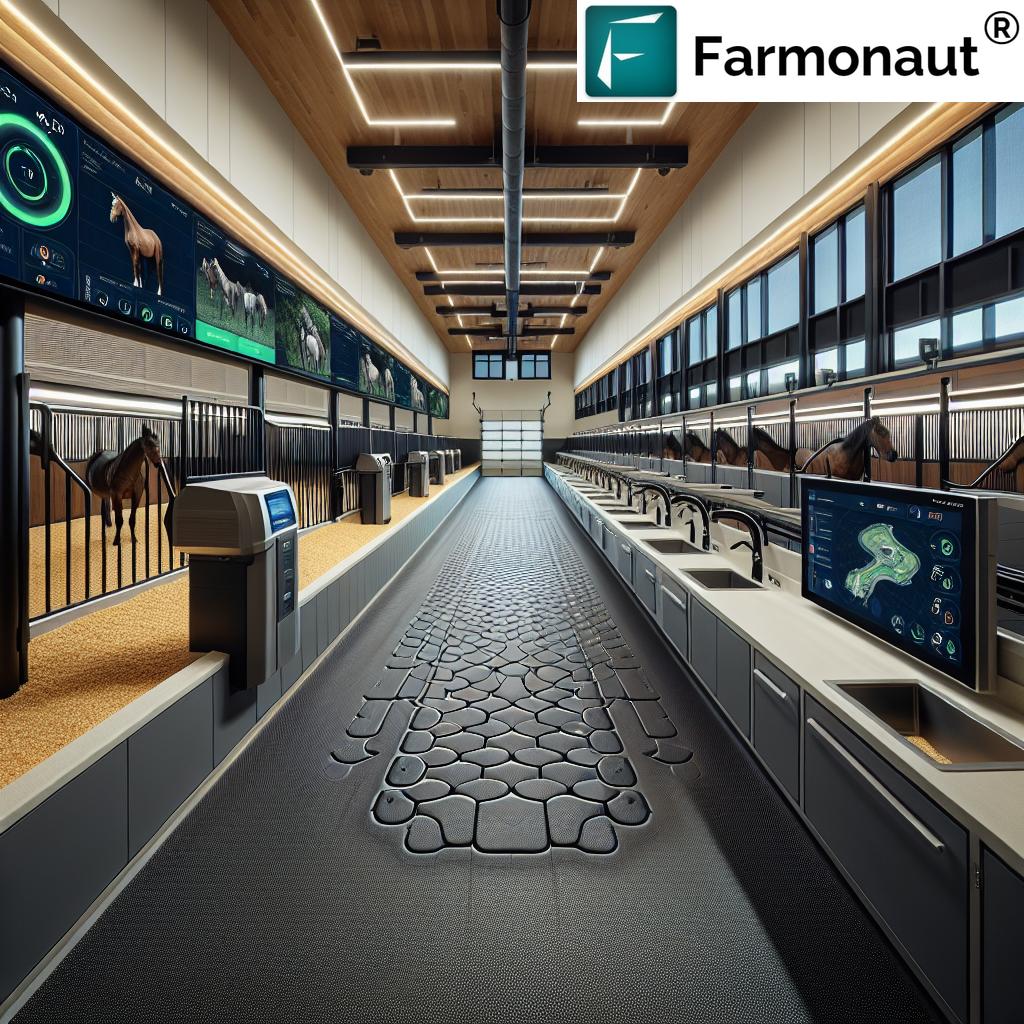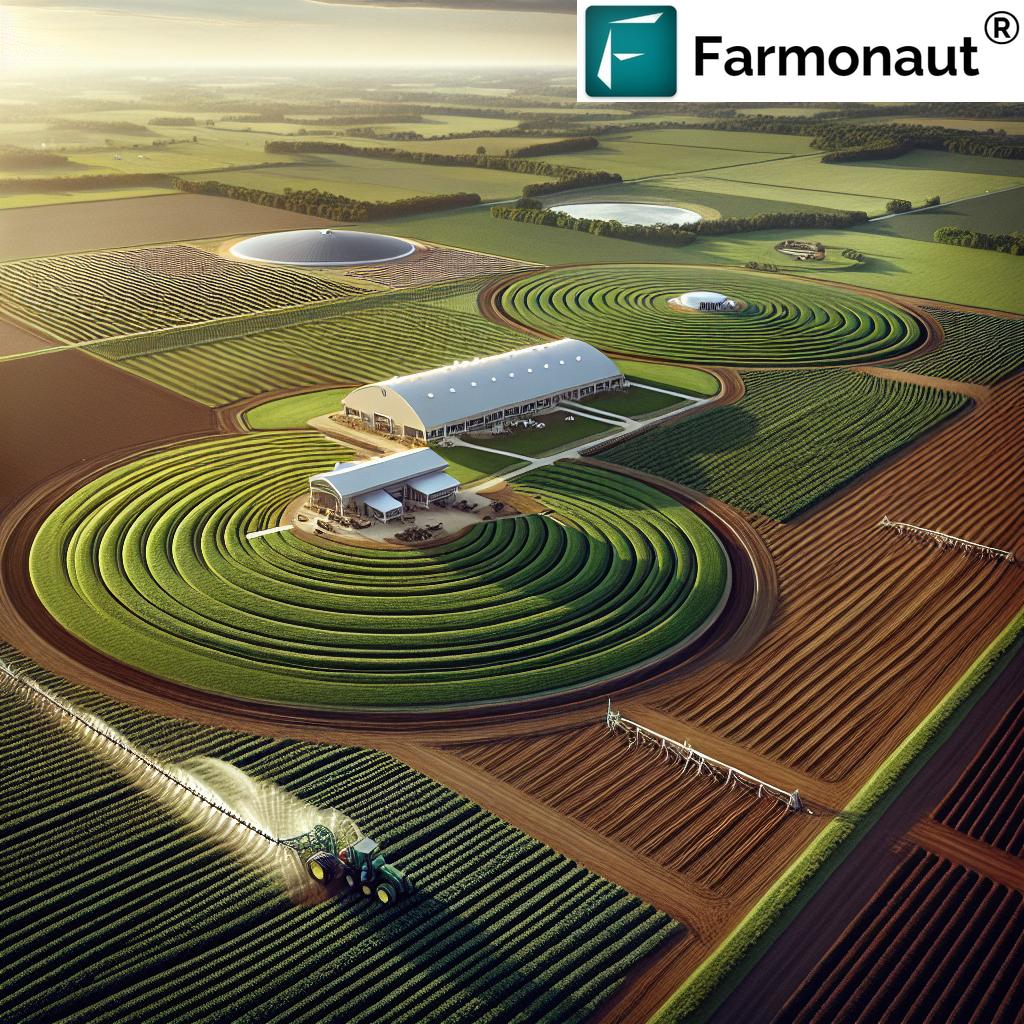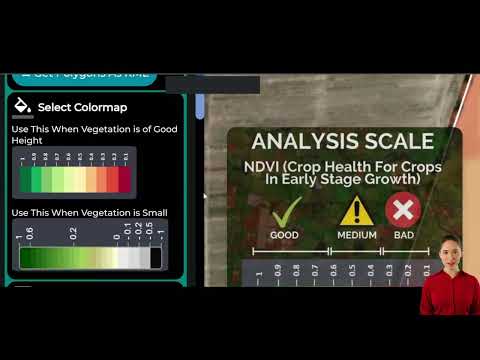Revolutionizing Equine Care: Innovative Technologies Transforming Horse Welfare and Performance in Ohio

“Ohio’s equine industry adopts over 50 new technologies annually, improving horse welfare and performance.”
Welcome to the forefront of equine care innovation! In this comprehensive blog post, we’ll explore the cutting-edge technologies revolutionizing horse welfare and performance in Ohio. As the equestrian world evolves, so does the need for advanced solutions to enhance the lives of our equine companions. We’ll delve into the latest advancements in equine welfare technology, innovative stable flooring, and state-of-the-art horse care practices that are transforming the industry.
At Farmonaut, we’re committed to bringing you the latest insights in agricultural technology, and today we’re focusing on how these innovations are impacting the equine sector. While our expertise lies in satellite-based farm management solutions, we recognize the importance of staying informed about all aspects of agricultural advancement, including equine care.
The Evolution of Equine Care in Ohio
Ohio has long been a hub for equestrian activities, with a rich history in horse breeding, racing, and show competitions. As the industry grows, so does the demand for advanced equine welfare technology. Let’s explore how innovative technologies are transforming horse care in the Buckeye State.
- Precision monitoring of horse health and performance
- Advanced stable management systems
- Data-driven training and nutrition programs
- Enhanced safety measures for both horses and riders
These advancements are not just improving the lives of horses; they’re also revolutionizing the way equestrian professionals approach their work. From small family farms to large competitive stables, the impact of these technologies is being felt across Ohio’s equine industry.
Innovative Stable Flooring: A Foundation for Equine Health
One of the most significant advancements in equine care has been the development of innovative stable flooring. Traditional materials like concrete or wood can be hard on horses’ joints and hooves, leading to long-term health issues. Modern flooring solutions are designed to provide comfort, support, and improved hygiene for horses.
Key benefits of advanced flooring systems include:
- Shock absorption to reduce joint stress
- Improved traction to prevent slips and falls
- Antimicrobial properties to maintain a hygienic environment
- Easy cleaning and maintenance for stable staff
These innovative flooring options are becoming increasingly popular in Ohio’s equestrian facilities, contributing to better overall horse health and reduced veterinary costs.
Advanced Feeding Systems: Precision Nutrition for Peak Performance
“Advanced feeding systems in Ohio stables reduce feed waste by up to 30% while enhancing equine nutrition.”
Nutrition plays a crucial role in horse health and performance. Advanced feeding systems are revolutionizing how we approach equine nutrition, offering precision and efficiency that was previously unattainable.
Features of modern equine feeding systems:
- Automated feed dispensers with customizable schedules
- Real-time monitoring of food and water intake
- Integration with health monitoring systems for personalized nutrition plans
- Reduction in feed waste and labor costs
These systems not only ensure that horses receive the right amount of food at the right times but also provide valuable data for veterinarians and nutritionists to optimize equine diets.
Wearable Technology: Monitoring Equine Health in Real-Time
The advent of wearable technology has transformed equine health management. From smart halters to leg sensors, these devices provide real-time data on a horse’s vital signs, activity levels, and even sleep patterns.
Applications of equine wearable technology:
- Early detection of health issues
- Monitoring of recovery after injuries or surgeries
- Performance tracking during training and competitions
- Stress level assessment in various environments
By leveraging this technology, Ohio’s equestrian professionals can make data-driven decisions about training intensity, rest periods, and overall horse management.
Climate Control Systems: Creating Optimal Environments for Horses
Ohio’s variable climate can pose challenges for horse care. Advanced climate control systems in stables are addressing this issue, providing horses with comfortable and healthy living conditions year-round.
Benefits of equine climate control:
- Regulation of temperature and humidity
- Improved air quality through advanced filtration
- Reduction in respiratory issues and heat stress
- Enhanced comfort leading to better rest and recovery
These systems are particularly valuable in Ohio, where temperatures can fluctuate dramatically between seasons, ensuring that horses remain comfortable regardless of outdoor conditions.
Data-Driven Training Tools: Enhancing Equestrian Performance
The integration of data analytics into equestrian training has opened new avenues for performance enhancement. Trainers in Ohio are increasingly turning to technology to fine-tune their methods and achieve optimal results.
Innovative training tools include:
- Motion capture systems for gait analysis
- Virtual reality simulators for rider training
- AI-powered video analysis for technique improvement
- Biofeedback devices for both horse and rider
These tools provide objective data that complements the trainer’s expertise, leading to more effective training programs and improved performance in competitions.
Farmonaut’s Contribution to Agricultural Innovation
While our focus at Farmonaut is on satellite-based farm management solutions, we recognize the importance of technological advancements across all sectors of agriculture, including equine care. Our platform provides valuable insights for land management and crop health, which can be beneficial for farms that combine equestrian facilities with crop production.
Farmonaut’s technology can assist equestrian facilities in several ways:
- Monitoring pasture health for grazing horses
- Optimizing land use for hay production
- Tracking weather patterns to plan outdoor activities
- Managing water resources for stable operations
To learn more about how Farmonaut’s solutions can benefit your agricultural operations, visit our API page or check out our API Developer Docs.
The Impact of Technology on Equine Veterinary Care
Veterinary care for horses has been significantly enhanced by technological advancements. Ohio’s equine veterinarians are leveraging these innovations to provide better diagnostic and treatment options.
Technological advancements in equine veterinary care:
- Portable diagnostic imaging devices for on-site examinations
- Telemedicine platforms for remote consultations
- 3D-printed prosthetics and orthotics for injured horses
- Advanced surgical techniques using robotic assistance
These technologies are not only improving the quality of care but also making it more accessible to horse owners across Ohio.
Sustainable Practices in Equine Care
Sustainability is becoming increasingly important in all aspects of agriculture, including equine care. Ohio’s equestrian facilities are adopting eco-friendly practices that benefit both horses and the environment.
Sustainable innovations in equine care:
- Solar-powered stable systems
- Rainwater harvesting for stable use
- Composting systems for manure management
- Energy-efficient lighting and climate control
These practices not only reduce the environmental impact of equestrian facilities but can also lead to significant cost savings in the long run.
The Role of Artificial Intelligence in Equine Management
Artificial Intelligence (AI) is making significant inroads in equine management, offering predictive analytics and automated decision-making capabilities that were once thought impossible.
Applications of AI in equine care:
- Predictive health models for early disease detection
- Automated feeding adjustments based on individual horse needs
- Optimization of training schedules for peak performance
- Smart stable management systems for efficient operations
AI technologies are helping Ohio’s equestrian professionals make more informed decisions, leading to better outcomes for horses and more efficient stable management.
Enhancing Equine Safety with Technology
Safety is paramount in equestrian activities, and technology is playing a crucial role in minimizing risks for both horses and riders.
Innovative safety technologies include:
- Smart helmets with impact sensors and emergency alerts
- GPS tracking systems for trail riding and competitions
- Advanced fencing systems with real-time monitoring
- Automated emergency response systems in stables
These technologies provide an extra layer of protection, giving horse owners and riders peace of mind during various equestrian activities.
The Future of Equine Care Technology
As we look to the future, the potential for further technological advancements in equine care is immense. Emerging technologies like gene editing, nanotechnology, and advanced robotics could revolutionize how we care for and interact with horses.
Potential future innovations:
- Personalized medicine based on genetic profiles
- Nano-sensors for real-time health monitoring at the cellular level
- Robotic assistants for stable management and horse care
- Virtual and augmented reality for advanced rider training
While these technologies may seem futuristic, the rapid pace of innovation suggests that they could become reality sooner than we think.
Challenges and Considerations
While the benefits of these technologies are clear, their implementation comes with challenges that Ohio’s equestrian community must address.
Key considerations include:
- Initial costs of implementing new technologies
- Training staff to use and maintain advanced systems
- Ensuring data privacy and security
- Balancing technology use with traditional horsemanship
Addressing these challenges will be crucial for the successful integration of new technologies into equine care practices.
Comparative Analysis of Innovative Equine Technologies
To provide a clear overview of the technologies discussed, we’ve compiled a comparative table of innovative equine technologies:
| Technology Name | Primary Function | Benefits to Horse Health | Performance Enhancement | Estimated Cost Range | Adoption Rate in Ohio (%) |
|---|---|---|---|---|---|
| Advanced Stable Flooring | Comfort and hygiene | Reduced joint stress, improved hygiene | Better rest, reduced injury risk | $5,000 – $20,000 per stable | 35% |
| Smart Feeding Systems | Precision nutrition | Optimized diet, reduced digestive issues | Improved energy levels, tailored nutrition | $2,000 – $10,000 per system | 28% |
| Wearable Health Monitors | Real-time health tracking | Early detection of health issues | Optimized training, stress management | $500 – $2,000 per device | 42% |
| Climate Control Systems | Environmental regulation | Reduced respiratory issues, thermal comfort | Consistent training conditions | $10,000 – $50,000 per stable | 20% |
| Data-Driven Training Tools | Performance analysis | Injury prevention, targeted improvement | Enhanced technique, tailored training plans | $1,000 – $15,000 per system | 30% |
This table provides a snapshot of how these technologies compare in terms of their functions, benefits, costs, and current adoption rates in Ohio. It’s clear that while adoption rates vary, there’s significant potential for growth across all categories.
Integrating Technology with Traditional Horsemanship
While technology offers numerous benefits, it’s essential to integrate these advancements with traditional horsemanship practices. The human-horse bond remains at the core of equestrian activities, and technology should enhance, not replace, this relationship.
Balancing technology and tradition:
- Using data to inform, not dictate, training decisions
- Maintaining hands-on care alongside automated systems
- Preserving the art of horsemanship while leveraging scientific advancements
- Educating equestrian professionals on the effective use of new technologies
By finding this balance, Ohio’s equestrian community can reap the benefits of innovation while preserving the timeless aspects of horse care and training.
The Economic Impact of Equine Technology in Ohio
The adoption of advanced technologies in Ohio’s equine industry is not just improving horse welfare and performance; it’s also having a significant economic impact on the state.
Economic benefits include:
- Creation of new jobs in equine technology sectors
- Increased efficiency leading to cost savings for stables and farms
- Enhanced competitiveness of Ohio’s equestrian events and facilities
- Attraction of investment in equine-related businesses and research
As Ohio continues to embrace these innovations, the state is positioning itself as a leader in equine technology, potentially attracting more equestrian events and businesses to the region.
Education and Training for the Future of Equine Care
With the rapid advancement of technology in equine care, there’s a growing need for education and training programs to ensure that equestrian professionals are equipped to leverage these new tools effectively.
Educational initiatives may include:
- Specialized courses in equine technology at veterinary and agricultural schools
- Workshops and seminars for current professionals to stay updated on new technologies
- Online training modules for remote learning and continuous education
- Partnerships between technology companies and equestrian organizations for hands-on training
By investing in education, Ohio can ensure that its equestrian workforce remains at the forefront of technological advancements in horse care.
Conclusion: The Bright Future of Equine Care in Ohio
As we’ve explored throughout this blog post, the equine care landscape in Ohio is undergoing a remarkable transformation driven by innovative technologies. From advanced stable flooring to AI-powered management systems, these advancements are revolutionizing how we care for, train, and interact with horses.
The benefits are clear: improved horse welfare, enhanced performance, increased safety, and more efficient operations. However, the successful integration of these technologies requires a thoughtful approach that balances innovation with traditional horsemanship.
Ohio’s equestrian community is well-positioned to lead the way in adopting and adapting these technologies, potentially setting new standards for equine care across the nation. As we look to the future, the possibilities for further advancements are exciting, promising even greater strides in horse health, performance, and the overall equestrian experience.
At Farmonaut, while our primary focus is on satellite-based farm management solutions, we’re excited to see how technological innovations are transforming all aspects of agriculture, including equine care. We believe that by embracing these advancements, Ohio’s equestrian industry can achieve new heights of excellence, ensuring a bright and prosperous future for horses and horse enthusiasts alike.
FAQ: Innovative Technologies in Equine Care
Q1: How are wearable technologies improving horse health monitoring?
A1: Wearable technologies for horses, such as smart halters and leg sensors, provide real-time data on vital signs, activity levels, and sleep patterns. This continuous monitoring allows for early detection of health issues, more accurate tracking of recovery after injuries, and the ability to optimize training regimens based on individual horse data.
Q2: What are the benefits of advanced stable flooring systems?
A2: Advanced stable flooring systems offer multiple benefits including shock absorption to reduce joint stress, improved traction to prevent slips and falls, antimicrobial properties for better hygiene, and easier maintenance. These features contribute to better overall horse health and comfort, potentially reducing the risk of injuries and respiratory issues.
Q3: How is artificial intelligence (AI) being used in equine management?
A3: AI is being applied in various aspects of equine management, including predictive health models for early disease detection, automated feeding adjustments based on individual horse needs, optimization of training schedules for peak performance, and smart stable management systems for efficient operations.
Q4: What role does climate control technology play in horse care?
A4: Climate control systems in stables help regulate temperature and humidity, improve air quality through advanced filtration, and reduce the risk of respiratory issues and heat stress. This technology ensures horses remain comfortable year-round, regardless of outdoor conditions, which is particularly valuable in regions with variable climates like Ohio.
Q5: How are data-driven training tools enhancing equestrian performance?
A5: Data-driven training tools, such as motion capture systems for gait analysis, virtual reality simulators for rider training, and AI-powered video analysis, provide objective data to complement trainers’ expertise. These tools allow for more precise technique refinement, personalized training programs, and improved overall performance in competitions.





















